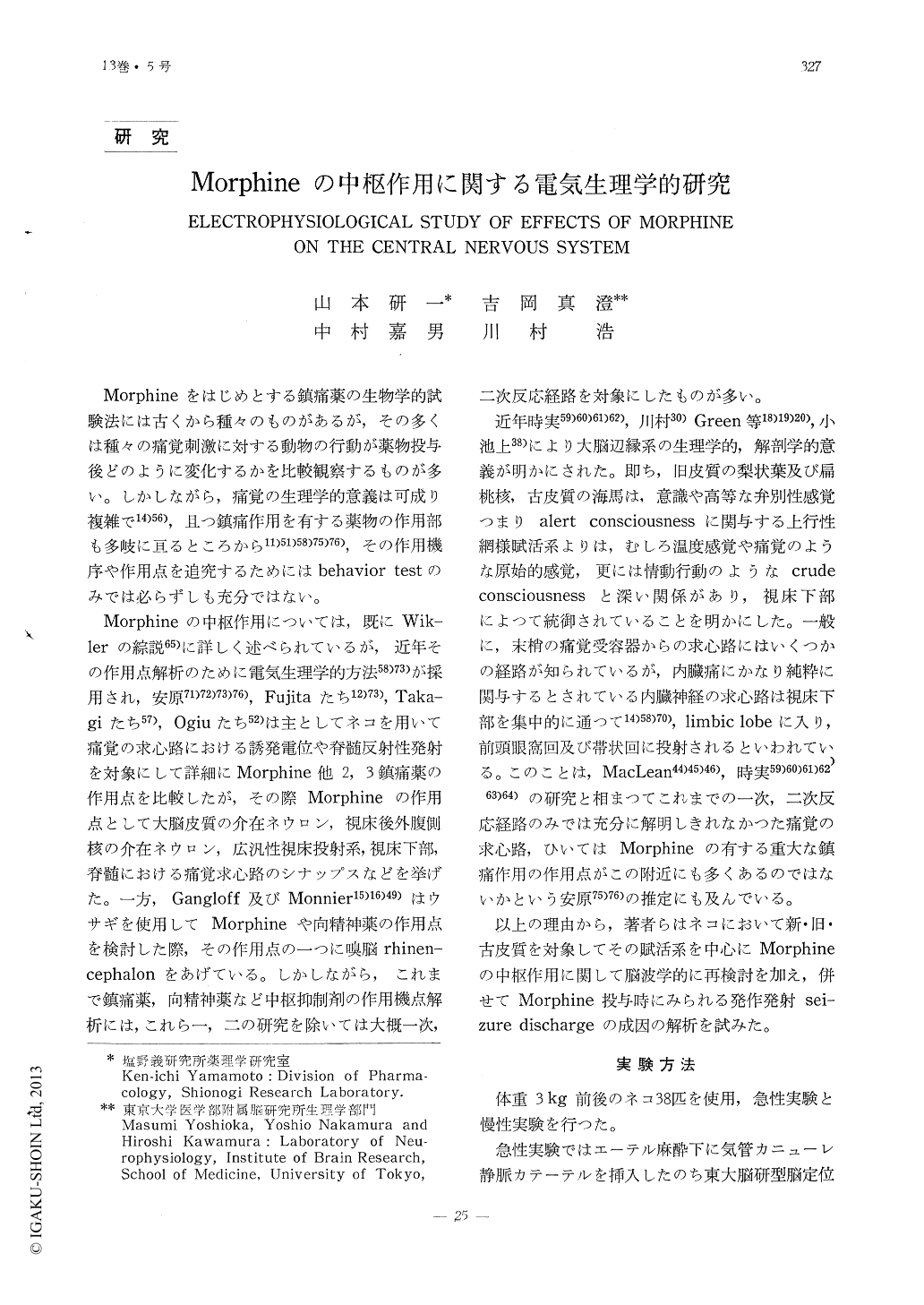Japanese
English
- 有料閲覧
- Abstract 文献概要
- 1ページ目 Look Inside
ネコを用いてクラーレ処置,工入呼吸下の急性実験ならびに植込み電極法による慢性実験を行いMorphine(10mg/kg静脈注射)の行動ならびに新皮質,扁桃核,海馬の電気的活動及びその賦活系に及ぼす影響を検討し,併せてMorphine投与時にみられる発作発射の成因解析を行つた。
1.Morphine投与後ネコの行動は終始睡眠に入らずむしろ興奮がみられ,且つ周囲に対して無関心になる。この時流挺,散瞳,呼吸抑制,脱糞,後肢麻痺などの症状が随伴する。
新皮質の脳波パタンは大概低振幅速波の覚醒波であるが,扁桃核,海馬の電気活動水準は傾眠時様に低下し,新皮質と旧,古皮質の電気的活動の間に分離を生じる。
2.Morphineは視床下部前部→扁桃核,視床下部後部→海馬の脳波覚醒反応閾値を共に著明に上昇させる。
3.Morphineは視床正中核→新皮質,中脳網様体→新皮質,中心灰白質→新皮質の脳波覚醒反応閾値をあまり上昇させないが,同じ刺激により出現する海馬覚醒波の閾値は著明に上昇させる。このことから,Morphineは中脳網様体——視床非特殊中継核——新皮質の系にはあまり作用せずむしろ中脳網様体——視床下部——大脳辺縁系に強い抑制作用を有するものと推定される。
4.Morphineは坐骨神経,後肢足蹠に対する痛覚刺激,内臓神経刺激による脳波覚醒反応閾値を新皮質,海馬共に上昇させるから,その抑制部位は脊髄とみなされる。
Ⅰ. Effect of morphine on the afferent path- way of pain sensation.
In chronically electrode-implanted cats, ve-getative symptoms such as salivation, de-crease of respiration and heart rate were seen immediately after the intravenous administra-tion of 10 mg/kg morphine. Within ten minutes after injection the animal gradually showed behavioral excitation and disappea-rance of freindlyness. At this time, low voltage fast waves in the sensory-motor and the auditory area of the cerebral cortex (neocortex) were recorded, while drowsy pattern in the amygdala (paleocortex) and the hippocampus (archicortex) were observed despite of behavioral arousal of animal.
The same dissociation between the neocor-tex and the paleo-, archicortex was also observed in curarized cats after the ad-ministration of the same dose of morphine. The mechanism of this dissociation was stu-died comparing the elevation of arousal thres-hold in each activating system using cura-rized cats. The results were as follows.
1. Threshold of electrographic activation in the hypothalamic activating system, which was described by TOKIZANE, was markedly elevated after the ad- ministration of morphine.

Copyright © 1961, Igaku-Shoin Ltd. All rights reserved.


